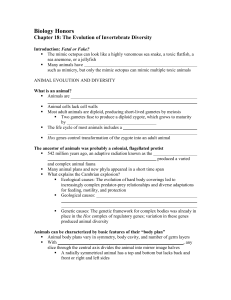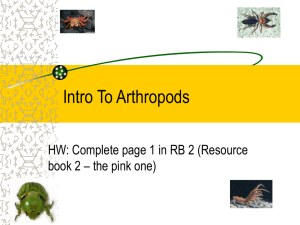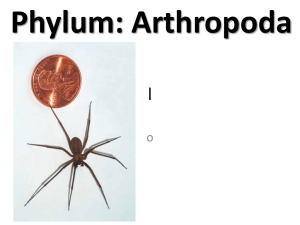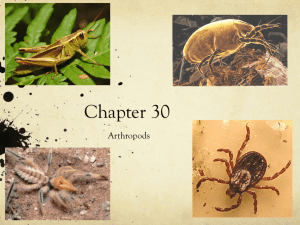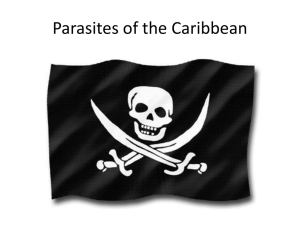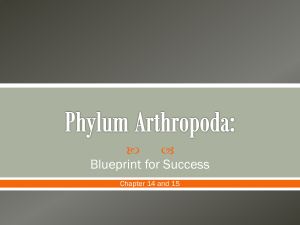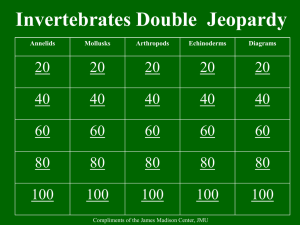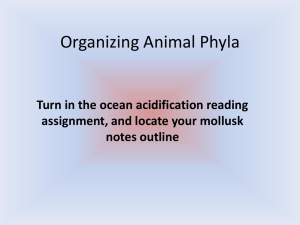D. Protostomia: Ecdysozoa
advertisement
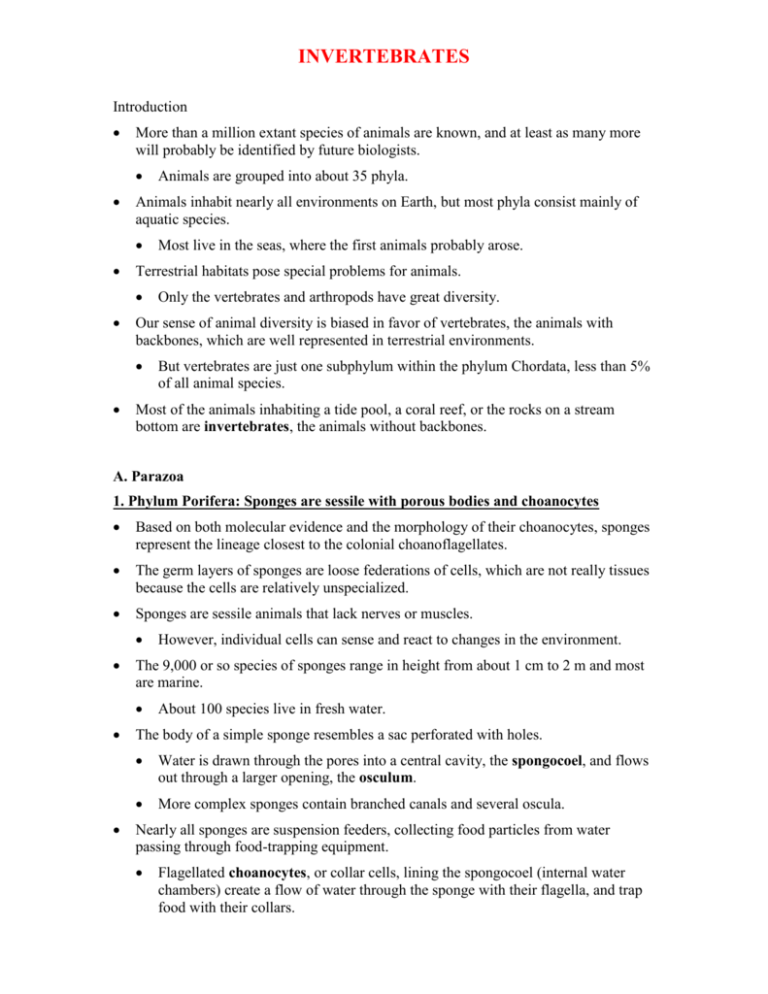
INVERTEBRATES Introduction More than a million extant species of animals are known, and at least as many more will probably be identified by future biologists. Animals inhabit nearly all environments on Earth, but most phyla consist mainly of aquatic species. Only the vertebrates and arthropods have great diversity. Our sense of animal diversity is biased in favor of vertebrates, the animals with backbones, which are well represented in terrestrial environments. Most live in the seas, where the first animals probably arose. Terrestrial habitats pose special problems for animals. Animals are grouped into about 35 phyla. But vertebrates are just one subphylum within the phylum Chordata, less than 5% of all animal species. Most of the animals inhabiting a tide pool, a coral reef, or the rocks on a stream bottom are invertebrates, the animals without backbones. A. Parazoa 1. Phylum Porifera: Sponges are sessile with porous bodies and choanocytes Based on both molecular evidence and the morphology of their choanocytes, sponges represent the lineage closest to the colonial choanoflagellates. The germ layers of sponges are loose federations of cells, which are not really tissues because the cells are relatively unspecialized. Sponges are sessile animals that lack nerves or muscles. The 9,000 or so species of sponges range in height from about 1 cm to 2 m and most are marine. However, individual cells can sense and react to changes in the environment. About 100 species live in fresh water. The body of a simple sponge resembles a sac perforated with holes. Water is drawn through the pores into a central cavity, the spongocoel, and flows out through a larger opening, the osculum. More complex sponges contain branched canals and several oscula. Nearly all sponges are suspension feeders, collecting food particles from water passing through food-trapping equipment. Flagellated choanocytes, or collar cells, lining the spongocoel (internal water chambers) create a flow of water through the sponge with their flagella, and trap food with their collars. The body of a sponge consists of two cell layers separated by a gelatinous region, the mesohyl. Wandering though the mesohyl are amoebocytes. They take up food from water and from choanocytes, digest it, and carry nutrients to other cells. They also secrete tough skeletal fibers within the mesohyl. In some groups of sponges, these fibers are sharp spicules of calcium carbonate or silica. Other sponges produce more flexible fibers from a collagen protein called spongin. We use these pliant, honeycombed skeletons as bath sponges. Most sponges are hermaphrodites, with each individual producing both sperm and eggs. Gametes arise from choanocytes or amoebocytes. The eggs are retained, but sperm are carried out the osculum by the water current. Sperm are drawn into neighboring individuals and fertilize eggs in the mesohyl. The zygotes develop into flagellated, swimming larvae that disperse from the parent. When a larva finds a suitable substratum, it develops into a sessile adult. Sponges are capable of extensive regeneration, the replacement of lost parts. They use regeneration not only for repair but also to reproduce asexually from fragments broken off a parent sponge. B. Radiata All animals except sponges belong to the Eumetazoa, the animals with true tissues. The oldest eumetazoan clade is the Radiata, animals with radial symmetry and diploblastic embryos. The two phyla of Radiata, Cnidaria and Ctenophora, may have had separate origins from different protozoan ancestors. 1. Phylum Cnidaria: Cnidarians have radial symmetry, a gastrovascular cavity, and cnidocytes The cnidarians (hydras, jellies, sea anemones, and coral animals) have a relatively simple body construction. They are a diverse group with over 10,000 living species, most of which are marine. The basic cnidarian body plan is a sac with a central digestive compartment, the gastrovascular cavity. This basic body plan has two variations: the sessile polyp and the floating medusa. The cylindrical polyps, such as hydras and sea anemones, adhere to the substratum by the aboral end and extend their tentacles, waiting for prey. Medusas (also called jellies) are flattened, mouth-down versions of polyps that move by drifting passively and by contracting their bell-shaped bodies. Some cnidarians exist only as polyps. Others exist only as medusas. Still others pass sequentially through both a medusa stage and a polyp stage in their life cycle. Cnidarians are carnivores that use tentacles arranged in a ring around the mouth to capture prey and push the food into the gastrovascular chamber for digestion. Batteries of cnidocytes on the tentacles defend the animal or capture prey. Organelles called cnidae evert a thread that can inject poison into the prey, or stick to or entangle the target. Cnidae called nematocysts are stinging capsules. Muscles and nerves exist in their simplest forms in cnidarians. Cells of the epidermis and gastrodermis have bundles of microfilaments arranged into contractile fibers. True muscle tissue appears first in triploblastic animals. When the animal closes its mouth, the gastrovascular cavity acts as a hydrostatic skeleton against which the contractile cells can work. Movements are controlled by a noncentralized nerve net associated with simple sensory receptors that are distributed radially around the body. The phylum Cnidaria is divided into three major classes: Hydrozoa, Scyphozoa, and Anthozoa. The three cnidarian classes show variations on the same body theme of polyp and medusa. Most hydrozoans alternate polyp and medusa forms, as in the life cycle of Obelia. Hydras, among the few freshwater cnidarians, are unusual members of the class Hydrozoa in that they exist only in the polyp form. When environmental conditions are favorable, a hydra reproduces asexually by budding, the formation of outgrowths that pinch off from the parent to live independently. When environmental conditions deteriorate, hydras form resistant zygotes that remain dormant until conditions improve. The medusa generally prevails in the life cycle of class Scyphozoa. The medusas of most species live among the plankton as jellies. Most coastal scyphozoans go through small polyp stages during their life cycle. The polyp stage, often a colony of interconnected polyps, is more conspicuous than the medusas. Jellies that live in the open ocean generally lack the sessile polyp. Sea anemones and corals belong to the class Anthozoa. They occur only as polyps. Coral animals live as solitary or colonial forms and secrete a hard external skeleton of calcium carbonate. Each polyp generation builds on the skeletal remains of earlier generations to form skeletons that we call coral. In tropical seas, coral reefs provide habitat for a great diversity of invertebrates and fishes. Coral reefs in many parts of the world are currently being damaged by environmental changes - global warming is one suspect. 2. Phylum Ctenophora: Comb jellies possess rows of ciliary plates and adhesive colloblasts Comb jellies, or ctenophores, superficially resemble cnidarian medusas. However, the relationship between phyla is uncertain. All of the approximately 100 species are marine. Some species are spherical or ovoid, others are elongated and ribbonlike. Ctenophora means “comb-bearer” and these animals are named for their eight rows of comb-like plates composed of fused cilia. Most comb jellies have a pair of long retractable tentacles. These tentacles are armed with adhesive structures (colloblasts) that secrete a sticky thread to capture their food. C. Protostomia: Lophotrochozoa The molecular-based phylogeny of the clade Bilateria implies that the original bilateral animals, the urbilateria, were relatively complex animals with true body cavities (coeloms). Both molecular clock estimates and trace fossils (burrows) place the origin of bilaterans in the Precambrian. If this is true, then simpler bilaterans lacking coeloms (acoelomates) and those with pseudocoeloms evolved secondarily from coelomates. These burrows indicate the presence of a hydraulic skeleton that can function in burrowing. The molecular data reinforce the traditional division of the bilateral animals into the protostomes and deuterostomes. However, the molecular phylogeny splits the protostomes into two clades: Lophotrochozoa and Ecdysozoa. 1. Phylum Platyhelminthes: Flatworms are acoelomates with gastrovascular cavities There are about 20,000 species of flatworms living in marine, freshwater, and damp terrestrial habitats. They also include many parasitic species, such as the flukes and tapeworms. Flatworms have thin bodies, ranging in size from the nearly microscopic to tapeworms over 20 m long. Flatworms and other bilaterians are triploblastic, with a middle embryonic tissue layer, mesoderm, which contributes to more complex organs and organs systems and to true muscle tissue. While flatworms are structurally more complex than cnidarians or ctenophores, they are simpler than other bilaterans. Like cnidarians and ctenophores, flatworms have a gastrovascular cavity with only one opening (and tapeworms lack a digestive system entirely and absorb nutrients across their body surface). Unlike other bilaterians, flatworms lack a coelom. Flatworms are divided into four classes: Turbellaria, Monogenia, Trematoda, and Cestoidea. Turbularians are nearly all free-living (nonparasitic) and most are marine. Planarians, members of the genus Dugesia, are carnivores or scavengers in unpolluted ponds and streams. Planarians and other flatworms lack organs specialized for gas exchange and circulation. Their flat shape places all cells close to the surrounding water and fine branching of the digestive system distributes food throughout the animal. Nitrogenous wastes are removed by diffusion and simple ciliated flame cells help maintain osmotic balance. Planarians move using cilia on the ventral epidermis, gliding along a film of mucus they secrete. Some turbellarians use muscles for undulatory swimming. A planarian has a head with a pair of eyespots to detect light and lateral flaps that function mainly for smell. The planarian nervous system is more complex and centralized than the nerve net of cnidarians. Planarians can reproduce asexually through regeneration. The parent constricts in the middle, and each half regenerates the missing end. Planarians can also reproduce sexually. Planarians can learn to modify their responses to stimuli. These hermaphrodites cross-fertilize. The monogeneans (class Monogenea) and the trematodes (class Trematoda) live as parasites in or on other animals. Many have suckers for attachment to their host. A tough covering protects the parasites. Reproductive organs nearly fill the interior of these worms. Trematodes parasitize a wide range of hosts, and most species have complex life cycles with alternation of sexual and asexual stages. Many require an intermediate host in which the larvae develop before infecting the final hosts (usually a vertebrate) where the adult worm lives. The blood fluke Schistosoma infects 200 million people, leading to body pains, and dysentery. Most monogeneans are external parasites of fishes. Their life cycles are simple, with a ciliated, free-living larva that starts an infection on a host. While traditionally aligned with trematodes, some structural and chemical evidence suggests that they are more closely related to tapeworms. Tapeworms (class Cestoidea) are also parasitic. The adults live mostly in vertebrates, including humans. Suckers and hooks on the head or scolex anchor the worm in the digestive tract of the host. A long series of proglottids, sacs of sex organs, lie posterior to the scolex. Tapeworms absorb food particles from their hosts. Mature proglottids, loaded with thousands of eggs, are released from the posterior end of the tapeworm and leave with the host’s feces. In one type of cycle, tapeworm eggs in contaminated food or water are ingested by intermediary hosts, such as pigs or cattle. The eggs develop into larvae that encyst in the muscles of their host. Humans acquire the larvae by eating undercooked meat contaminated with cysts. The larvae develop into mature adults within the human. 2. Phylum Rotifera: Rotifers are pseudocoelomates with jaws, crowns of cilia, and complete digestive tracts Rotifers, with about 1,800 species, are tiny animals (0.05 to 2 mm), most of which live in freshwater. Some live in the sea or in damp soil. Rotifers have a complete digestive tract with a separate mouth and anus. Internal organs lie in the pseudocoelom, a body cavity that is not completely lined with mesoderm. The fluid in the pseudocoelom serves as a hydrostatic skeleton. Through the movements of nutrients and wastes dissolved in the coelomic fluid, the pseudocoelom also functions as a circulatory system. The word rotifer, “wheel-bearer,” refers to the crown of cilia that draws a vortex of water into the mouth. Food particles drawn in by the cilia are captured by the jaws (trophi) in the pharynx and ground up. Some rotifers exist only as females that produce more females from unfertilized eggs, a type of parthenogenesis. Other species produce two types of eggs that develop by parthenogenesis. One type forms females and the other forms degenerate males that survive just long enough to fertilize eggs. The zygote forms a resistant stage that can withstand environmental extremes until conditions improve. The zygote then begins a new female generation that reproduces by parthenogenesis until conditions become unfavorable again. 3. The lophophorate phyla: Bryozoans, phoronids, and brachiopods are coelomates with ciliated tentacles around their mouths The traditional division of bilaterians into protostomes and deuterostomes based on embryology provided a poor fit to either group for the lophophorate phyla, including the Bryozoa, Phoronida, and Brachiopoda. Molecular data place the lophophorates squarely in the protostome branch. These phyla are known as the lophophorate animals, named after a common structure, the lophophore. The lophophore is a horseshoe-shaped or circular fold of the body wall bearing ciliated tentacles that surround and draw water toward the mouth. In addition to the lophophore, these three phyla share a U-shaped digestive tract and the absence of a head. These may be adaptations to a sessile existence. The lophophorates have true coeloms completely lined with mesoderm. Bryozoans (“moss animals”) are colonial animals that superficially resemble mosses. In most species, the colony is encased in a hard exoskeleton. The lophophores extend through pores in the exoskeleton. Almost all the 5,000 species of bryozoans are marine. In the sea, they are widespread and numerous sessile animals, with several species that can be important reef builders. Phoronids are tube-dwelling marine worms ranging from 1 mm to 50 cm in length. Some live buried in the sand within chitinous tubes. They extend the lophophore from the tube when feeding and pull it back in when threatened. There are about 15 species of phoronids in two genera. Brachiopods, or lamp shells, superficially resemble clams and other bivalve mollusks. However, the two halves of the brachiopod are dorsal and ventral to the animal, rather than lateral as in clams. Brachiopods live attached to the substratum by a stalk. All of the 330 extant species of brachiopods are marine. These are remnants of a richer past. 30,000 species of brachiopod fossils have been described from the Paleozoic and Mesozoic eras. 4. Phylum Nemertea: Proboscis worms are named for their prey-capturing apparatus The members of the Phylum Nemertea, proboscis worms or ribbon worms, have bodies much like that of flatworms. However, they have a small fluid-filled sac that may be a reduced version of a true coelom. The sac and fluid hydraulics operate an extensible proboscis which the worm uses to capture prey. Proboscis worms range in length from less than 1 mm to more than 30 m. Nearly all of the more than 900 species are marine, but a few species inhabit fresh water or damp soil. Some are active swimmers, and others burrow into the sand. Proboscis worms and flatworms have similar excretory, sensory, and nervous systems. However, nemerteans have a complete digestive tract and a closed circulatory system in which the blood is contained in vessels. 5. Phylum Mollusca: Mollusks have a muscular foot, a visceral mass, and a mantle The phylum Mollusca includes 150,000 known species of diverse forms, including snails and slugs, oysters and clams, and octopuses and squids. Most mollusks are marine, though some inhabit fresh water, and some snails and slugs live on land. Mollusks are soft-bodied animals, but most are protected by a hard shell of calcium carbonate. Slugs, squids, and octopuses have reduced or lost their shells completely during their evolution. Despite their apparent differences, all mollusks have a similar body plan with a muscular foot (typically for locomotion), a visceral mass with most of the internal organs, and a mantle. The mantle, which secretes the shell, drapes over the visceral mass and creates a water-filled chamber, the mantle cavity, with the gills, anus, and excretory pores. Most mollusks have separate sexes, with gonads located in the visceral mass. However, many snails are outcrossing hermaphrodites. The life cycle of many marine mollusks includes a ciliated larvae, the trochophore. Many mollusks feed by using a straplike rasping organ, a radula, to scrape up food. This larva is also found in marine annelids (segmented worms) and some other lophotrochozoans. The basic molluscan body plan has evolved in various ways in the eight classes of the phylum. The four most prominent are the Polyplacophora (chitons), Gastropoda (snails and slugs), Bivalvia (clams, oysters, and other bivalves), and Cephalopoda (squids, octopuses, and nautiluses). Chitons are marine animals with oval shapes and shells divided into eight dorsal plates. Chitons use their muscular foot to grip the rocky substrate tightly and to creep slowly over the rock surface. Chitons are grazers that use their radulas to scrape and ingest algae. Most of the more than 40,000 species in the Gastropoda are marine, but there are also many freshwater species. Garden snails and slugs have adapted to land. During embryonic development, gastropods undergo torsion in which the visceral mass is rotated up to 180 degrees, such that the anus and mantle cavity are above the head in adults. Most gastropods are protected by single, spiraled shells into which the animals can retreat if threatened. While the shell is typically conical, those of abalones and limpets are somewhat flattened. Other species have lost their shells entirely and may have chemical defenses against predators. Many gastropods have distinct heads with eyes at the tips of tentacles. They move by a rippling motion of their foot. Most gastropods use their radula to graze on algae or plant material. Some species are predators. In these species, the radula is modified to bore holes in the shells of other organisms or to tear apart tough animal tissues. In the tropical marine cone snails, teeth on the radula form separate poison darts, which penetrate and stun their prey, including fishes. Gastropods are among the few invertebrate groups to have successfully populated the land. In place of the gills found in most aquatic gastropods, the lining of the mantle cavity of terrestrial snails functions as a lung. The class Bivalvia includes clams, oysters, mussels, and scallops. Bivalves have shells divided into two halves. The two parts are hinged at the mid-dorsal line, and powerful adductor muscles close the shell tightly to protect the animal. When the shell is open, the bivalve may extend its hatchet-shaped foot for digging or anchoring. The mantle cavity of a bivalve contains gills that are used for feeding and gas exchange. Most bivalves are suspension feeders, trapping fine particles in mucus that coats the gills. Cilia convey the particles to the mouth. Water flows into the mantle cavity via the incurrent siphon, passes over the gills, and exits via the excurrent siphon. Most bivalves live rather sedentary lives. Sessile mussels secrete strong threads that tether them to rocks, docks, boats, and the shells of other animals. Clams can pull themselves into the sand or mud, using the muscular foot as an anchor. Scallops can swim in short bursts to avoid predators by flapping their shells and jetting water out their mantle cavity. Cephalopods use rapid movements to dart toward their prey which they capture with several long tentacles. Squids and octopuses use beak-like jaws to bite their prey and then inject poison to immobilize the victim. A mantle covers the visceral mass, but the shell is reduced and internal in squids, missing in many octopuses, and exists externally only in nautiluses. Fast movements by a squid occur when it contracts its mantle cavity and fires a stream of water through the excurrent siphon. By pointing the siphon in different directions, the squid can rapidly move in different directions. The foot of a cephalopod (“head foot”) has been modified into the muscular siphon and parts of the tentacles and head. Most squid are less than 75 cm long, but the giant squid, the largest invertebrate, may reach 17 m (including tentacles) and weigh about 2 tons. Most octopuses live on the seafloor. Cephalopods have an active, predaceous lifestyle. They creep and scurry using their eight arms in search of crabs and other food. Unique among mollusks, cephalopods have a closed circulatory system to facilitate the movements of gases, fuels, and wastes through the body. They have a well-developed nervous system with a complex brain and welldeveloped sense organs. This supports learning and complex behavior. The ancestors of octopuses and squids were probably shelled mollusks that took up a predaceous lifestyle. The loss of the shell occurred in later evolution. Shelled cephalopods called ammonites were the dominant invertebrate predators for hundreds of millions of years until they perished in Cretaceous mass extinction. Some were as large as truck tires. 6. Phylum Annelida: Annelids are segmented worms All annelids (“little rings”) have segmented bodies. There are about 15,000 species ranging in length from less than 1 mm to 3 m for the giant Australian earthworm. Annelids live in the sea, most freshwater habitats, and damp soil. The coelom of the earthworm, a typical annelid, is partitioned by septa, but the digestive tract, longitudinal blood vessels, and nerve cords penetrate the septa and run the animal’s length. The digestive system consists of a pharynx, an esophagus, a crop, a gizzard, and an intestine. The closed circulatory system carries blood with oxygen-carrying hemoglobin through dorsal and ventral vessels that are connected by segmental vessels. In each segment is a pair of excretory tubes, metanephridia, that remove wastes from the blood and coelomic fluid. Wastes are discharged through exterior pores. A brain-like pair of cerebral ganglia lie above and in front of the pharynx. The dorsal vessel and five pairs of esophageal vessels act as muscular pumps to distribute blood. A ring of nerves around the pharynx connects to a subpharyngeal ganglion. Earthworms are cross-fertilizing hermaphrodites. Two earthworms exchange sperm and then separate. The received sperm are stored while a special organ, the clitellum, secretes a mucous cocoon. As the cocoon slides along the body, it picks up eggs and stored sperm and slides off the body into the soil. Some earthworms can also reproduce asexually by fragmentation followed by regeneration. Most annelids, including earthworms, burrow in sand and silt. Some aquatic annelids swim in pursuit of food. The phylum Annelida is divided into three classes: Oligochaeta, Polychaeta, and Hirudinea. Each segment of a polychaete (“many setae”) has a pair of paddlelike or ridgelike parapodia (“almost feet”) that function in locomotion. Each parapodium has several chitinous setae. In many polychaetes, the rich blood vessels in the parapodia function as gills. Most polychaetes are marine. Many crawl on or burrow in the seafloor. A few drift and swim in the plankton. Others live in tubes that the worms make by mixing mucus with sand and broken shells. Polychaetes include carnivores, scavengers, and planktivores. The brightly colored fanworms trap plankton on feathery tentacles. The majority of leeches inhabit fresh water, but land leeches move through moist vegetation. Leeches range in size from about 1 to 30 cm. Many leeches feed on other invertebrates, but some blood-sucking parasites feed by attaching temporarily to other animals, including humans. Some parasitic species use blade-like jaws to slit the host’s skin, while others secrete enzymes that digest a hole through the skin. The leech secretes hirudin, an anticoagulant, into the wound, allowing the leech to suck as much blood as it can hold. Until this century, leeches were frequently used by physicians for bloodletting. Leeches are still used for treating bruised tissues and for stimulating the circulation of blood to fingers or toes that have been sewn back to hands or feet after accidents. The evolutionary significance of the coelom cannot be overemphasized. The coelom provides a hydrostatic skeleton that allows new and diverse modes of locomotion. It also provides body space for storage and for complex organ development. The coelom cushions internal structures and separates the action of the body wall muscles from those of the internal organs, such as the digestive muscles. Segmentation allows a high degree of specialization of body regions. Groups of segments are modified for different functions. D. Protostomia: Ecdysozoa The primary evidence for defining the clade Ecdysozoa is data from molecular systematics. All members of this group share the phenomenon of ecdysis, the shedding of an exoskeleton outgrown by the animal. 1. Phylum Nematoda: Roundworms are nonsegmented pseudocoelomates covered by tough cuticles Roundworms are found in most aquatic habitats, wet soil, moist tissues of plants, and the body fluids and tissues of animals. There are 90,000 described species, and perhaps ten times that number actually exist. They range in size from less than 1 mm to more than a meter. The cylindrical bodies of roundworms are covered with a tough exoskeleton, the cuticle. As the worm grows, it periodically sheds its old cuticle and secretes a new, larger one. They have a complete digestive tract and use the fluid in their pseudocoelom to transport nutrients since they lack a circulatory system. Their thrashing motion is due to contraction of longitudinal muscles. Nematodes usually engage in sexual reproduction. The sexes are separate in most species and fertilization is internal. Females may lay 100,000 or more fertilized eggs per day that produce resistant zygotes. Abundant, free-living nematodes live in moist soil and in decomposing organic matter on the bottom of lakes and oceans. They play a major role in decomposition and nutrient recycling. The soil nematode, Caenorhabitis elegans, has become a model organism in developmental biology. The nematodes also include many species that are important agricultural pests that attack plant roots. Other species parasitize animals. Over 50 nematode species, including various pinworms and hookworms, parasitize humans. Trichinella spiralis causes trichinosis when the nematode worms encyst in a variety of human organs, including skeletal muscle. They are acquired by eating undercooked meat that has juvenile worms encysted in the muscle tissue. 2. Arthropods are segmented coelomates with exoskeletons and jointed appendages The world arthropod population has been estimated at a billion billion (1018) individuals. Nearly a million arthropod species have been described - two out of every three organisms known are arthropods. This phylum is represented in nearly all habitats in the biosphere. On the criteria of species diversity, distribution, and sheer numbers, arthropods must be regarded as the most successful animal phylum. The diversity and success of arthropods are largely due to three features: body segmentation, a hard exoskeleton, and jointed appendages. Groups of segments and their appendages have become specialized for a variety of functions, permitting efficient division of labor among regions. The body of an arthropod is completely covered by the cuticle, an exoskeleton constructed from layers of protein and chitin. The exoskeleton protects the animal and provides points of attachment for the muscles that move appendages. It is thick and inflexible in some regions, such as crab claws, and thin and flexible in others, such as joints. The exoskeleton of arthropods is strong and relatively impermeable to water. Arthropods have well-developed sense organs, including eyes for vision, olfactory receptors for smell, and antennae for touch and smell. In order to grow, an arthropod must molt (ecdysis) its old exoskeleton and secrete a larger one, a process that leaves the animal temporarily vulnerable to predators and other dangers. Most sense organs are located at the anterior end of the animal, showing extensive cephalization. Arthropods have an open circulatory system in which hemolymph fluid is propelled by a heart through short arteries into sinuses (the hemocoel) surrounding tissues and organs. Hemolymph returns to the heart through valved pores. The true coelom is much reduced in most species. Arthropods have evolved a variety of specialized organs for gas exchange. Most aquatic species have gills with thin feathery extensions that have an extensive surface area in contact with water. Terrestrial arthropods generally have internal surfaces specialized for gas exchange. For example, insects have tracheal systems, branched air ducts leading into the interior from pores in the cuticle. Molecular systematics supports evidence from the fossil record and comparative anatomy that arthropods diverged early in their history into four main evolutionary lineages: Trilobites (all extinct.) Chelicerates (horseshoe crabs, scorpions, ticks, spiders, and the extinct eurypterids). Uniramians (centipedes, millipedes, and insects). Crustaceans (crabs, lobsters, shrimps, barnacles, and many others). Several morphological features distinguish these groups. While chelicerates have clawlike feeding appendages, chelicerae, uniramians and crustaceans have jawlike mandibles. Chelicerates lack sensory antennae and most have simple eyes (eyes with a single lens), but uniramians and crustaceans have antennae and usually a pair of compound eyes (multifaceted eyes with many separate focusing elements) in addition to simple eyes. While uniramians have a pair of antennae and uniramous (unbranched) appendages, crustaceans have two pairs of antennae and biramous (branched) appendages. The move onto land by several groups of arthropods (insects, millipedes, centipedes, some chelicerates, and few crustaceans) was made possible, in part, by the exoskeleton. While it initially evolved for protection and locomotion, on land the exoskeleton also solved problems of water loss because the cuticle is relatively impermeable to water, helping prevent desiccation. The firm exoskeleton also provided support when arthropods left the relative buoyancy of water. Chelicerates, insects, millipedes, and centipedes diversified on land in the late Silurian and early Devonian, following the colonization by plants. Traditionally, all the arthropods have been grouped into the phylum Arthropoda. However, arthropod taxonomy is in a state of flux. Many zoologists recognize the four great lineages as distinct phyla: phylum Trilobita, phylum Chelicerata, phylum Uniramia, and phylum Crustacea. Other systematists question the monophyly of the Uniramia, arguing that molecular and anatomical data support a closer relationship of insects to crustaceans than to centipedes and millipedes. While active research is still clarifying the history of life, the diversity of arthropods is fascinating, regardless of the classification of major groups as phyla, subphyla, or classes, depending on the taxonomic scheme. The trilobites, among the earliest arthropods, were common denizens of the shallow seas of the Paleozoic era but disappeared in the Permian extinction about 250 million years ago. Trilobites had pronounced segmentation, but their appendages showed little variation from segment to segment. Chelicerates have an anterior cephalothorax and a posterior abdomen. Their appendages are more specialized than those of trilobites, and the most anterior appendages are modified as chelicerae (pincers or fangs). Most marine chelicerates, including all the eurypterids (sea scorpions), are extinct. As arthropods evolved, the trend was toward fewer, more specialized segments and appendages. Only four marine species, including the horseshoe crab, survive today. The bulk of modern chelicerates are terrestrial and belong to the class Arachnida. These include scorpions, spiders, ticks, and mites. Nearly all ticks are blood-sucking parasites on the body surfaces of reptiles, birds, or mammals. Parasitic mites live on or in a wide variety of vertebrates and invertebrates. The arachnid cephalothorax has six pairs of appendages. There are four pairs of walking legs. A pair of pedipalps function in sensing or feeding. The chelicerae usually function in feeding. Spiders inject poison from glands on the chelicerae to immobilize their prey and while chewing their prey, spill digestive juices into the tissues and suck up the liquid meal. In most spiders, gas exchange is carried out by book lungs. These are stacked plates contained in an internal chamber. The plates present an extensive surface area, enhancing exchange of gases between the hemolymph and air. A unique adaptation of many spiders is the ability to catch flying insects in webs of silk. The silk protein is produced as a liquid by abdominal glands and spun by spinnerets into fibers that solidify. Web designs are characteristic of each species. Silk fibers have other functions, including as egg covers. Millipedes (class Diplopoda) are wormlike with two pairs of walking legs on each of their many segments. They eat decaying leaves and plant matter. They may have been among the earliest land animals. Centipedes (class Chilopoda) are terrestrial carnivores. The head has a pair of antennae and three pairs of appendages modified as mouth parts, including the jaw-like mandibles. Each segment in the trunk region has one pair of walking legs. Centipedes have poison claws on the anterior most trunk segment that paralyzes prey and aids in defense. In species diversity, insects (class Insecta) outnumber all other forms of life combined. They live in almost every terrestrial habitat and in fresh water, and flying insects fill the air. They are rare, but not absent, from the sea. The study of insects, entomology is a vast field with many subspecialties, including physiology, ecology, and taxonomy. Class Insecta is divided into about 26 orders. The oldest insect fossils date back to the Devonian period, about 400 million years ago. When flight evolved in the Carboniferous and Permian periods, it sparked an explosion in insect varieties. Diversification of mouth parts for feeding on gymnosperms and other Carboniferous plants also contributed to the adaptive radiation of insects. In one widely held hypothesis, the radiation of flowering plants triggered the greatest diversification of insects in the Cretaceous and early Tertiary periods. Flight is one key to the great success of insects. Flying animals can escape many predators, find food and mates, and disperse to new habitats faster than organisms that must crawl on the ground. Many insects have one or two pairs of wings that emerge from the dorsal side of the thorax. However, new research suggests that insects diversified first and, as pollinators and herbivores, may have caused the angiosperm radiation. Wings are extensions of the cuticle and are not true appendages. Several hypotheses have been proposed for the evolution of wings. In one hypothesis, wings first evolved as extensions of the cuticle that helped the insect absorb heat and were later modified for flight. A second hypothesis argues that wings allowed animals to glide from vegetation to the ground. Alternatively, wings may have served as gills in aquatic insects. Still another hypothesis proposes that insect wings functioned for swimming before they functioned for flight. Insect wings are also very diverse. Dragonflies, among the first insects to fly, have two similar pairs of wings. The wings of bees and wasps are hooked together and move as a single pair. Butterfly wings operate similarly because the anterior wings overlap the posterior wings. In beetles, the posterior wings function in flight, while the anterior wings act as covers that protect the flight wings when the beetle is on the ground or burrowing. The internal anatomy of an insect includes several complex organ systems. In the complete digestive system, there are regionally specialized organs with discrete functions. Metabolic wastes are removed from the hemolymph by Malpighian tubules, outpockets of the digestive tract. Respiration is accomplished by a branched, chitin-lined tracheal system that carries O2 from the spiracles directly to the cells. The insect nervous system consists of a pair of ventral nerve cords with several segmental ganglia. The two chords meet in the head, where the ganglia form several anterior segments are fused into a cerebral ganglion (brain). This structure is close to the antennae, eyes, and other sense organs concentrated on the head. Metamorphosis is central to insect development. In incomplete metamorphosis (seen in grasshoppers and some other orders), the young resemble adults but are smaller and have different body proportions. In complete metamorphosis, larval stages specialized for eating and growing change morphology completely during the pupal stage and emerge as adults. Reproduction in insects is usually sexual, with separate male and female individuals. Coloration, sound, or odor bring together opposite sexes at the appropriate time. In most species, sperm cells are deposited directly into the female’s vagina at the time of copulation. In a few species, females pick up a sperm packet deposited by a male. The females store sperm in the spermatheca, in some cases holding enough sperm from a single mating to last a lifetime. After mating, females lay their eggs on a food source appropriate for the next generation. Insects affect the lives of all other terrestrial organisms. Insects are important natural and agricultural pollinators. On the other hand, insects are carriers for many diseases, including malaria and African sleeping sickness. Insects compete with humans for food, consuming crops intended to feed and clothe human populations. Through a series of molts, the young look more and more like adults until it reaches full size. Billions of dollars each year are spent by farmers on pesticides to minimize losses to insects. While arachnids and insects thrive on land, most of the 40,000 species of crustaceans remain in marine and freshwater environments. A few crustaceans are terrestrial or semi-terrestrial. Crustaceans include lobsters, crabs, crayfish, shrimp, and barnacles, among many others. The multiple appendages of crustaceans are extensively specialized. For instance, lobsters and crayfish have 19 pairs of appendages, adapted to a variety of tasks. In addition to two pairs of antennae, crustaceans have three or more pairs of mouth parts, including hard mandibles. Walking legs are present on the thorax and other appendages for swimming or reproduction are found on the abdomen. Crustaceans can regenerate lost appendages during molting. Small crustaceans exchange gases across thin areas of the cuticle, but larger species have gills. The circulatory system is open, with a heat pumping hemolymph into short arteries and then into sinuses that bathe the organs. Nitrogenous wastes are excreted by diffusion through thin areas of the cuticle, but glands regulate the salt balance of the hemolymph. Most crustaceans have separate sexes. Males use a specialized pair of appendages to transfer sperm to the female’s reproductive pore. Most aquatic species have several larval stages. The isopods, with about 10,000 species, are one of the largest groups of crustaceans. Most are small marine species, but they can be abundant at the bottom of deep oceans. They also include the land-dwelling pill bugs, or wood lice, that live underneath moist logs and leaves. The copepods are among the most numerous of all animals. Decapods, including lobsters, crayfish, crabs, and shrimp, are among the largest crustaceans. The cuticle is hardened with calcium carbonate. The exoskeleton over the cephalothorax forms a shield called the carapace. While most decapods are marine, crayfish live in freshwater and some tropical crabs are terrestrial as adults. Related to decapods, krill are shrimplike planktonic organisms that reach about 3 cm long. A major food source for whales and other ocean predators, they are now harvested extensively by humans for food and agricultural fertilizer. Barnacles are sessile crustaceans with parts of their cuticle hardened by calcium carbonate. These small crustaceans are important members of marine and freshwater plankton communities, eating protists and bacteria and being eaten by many fishes. They strain food from the water by extending their appendages. The revision of the invertebrate phyla into the Lophotrochozoa and the Ecdysozoa has raised the issue of how often segmentation evolved in the animal kingdom. Until recently, the majority of biologists favored the hypothesis that arthropods evolved from the segmented annelids, or that both groups evolved from a common segmented ancestor. The molecular data would split these phyla into two different parts of the animal phylogenetic tree. This conflict has focused interest in the evolutionary origin of segmentation. The segmented bodies of arthropods and annelids represent a special case of a more general phenomenon: the blocking-out of an embryo into regions where certain body parts will develop. Differential expression of various regulatory genes that code for transcription factors plays a key role in this blocking-out of anterior -> posterior anatomy in the developing embryo. For example, differential expression of various Hox genes along the length of the lobster embryo causes antennae to develop on certain segments and walking legs on others. Hox genes are also present in nonsegmented animals and play an important role in development. An increase in Hox gene number through gene duplication and mutations, along with adaptation of Hox gene function for the development of segmented bodies, made it possible for a great diversity of complex animals to evolve. Body segmentation evolved in several of the 35 animal phyla, including annelids, arthropods, and chordates. Segmented animals occur in all three major clades of bilaterians. Each clade also includes nonsegmented animals. Three hypotheses can account for the scattered distribution of segmentation among animal phyla. In the first, segmentation had separate evolutionary origins in each bilaterian clade. In the second, there were two separate origins of segmentation, one for the protostomes and one for the deuterostomes. In the third, segmentation evolved just once, in a common ancestor to all three bilaterian lineages. Some phyla in the protostomes then lost segmentation. Several phyla in each group then lost segmentation. The principle of parsimony would seem to favor the first hypothesis because it involves the fewest evolutionary changes. However, application of parsimony is merely an analytical aid in cladistics, not a law of evolution that life always follows. Without more evidence, all three hypotheses remain plausible explanations for the distribution of segmentation among animal phyla. “Evo-devo,” at the interface of evolutionary biology and developmental biology, may answer some of these questions by comparing the roles of various regulatory genes during development. E. Deuterostomia At first glance, sea stars and other echinoderms would seem to have little in common with the phylum Chordata, which includes the vertebrates. However, these animals share the deuterostome characteristics of radial cleavage, development of the coelom from the archenteron, and the formation of the anus from the blastopore. These developmental features that define the Deuterostomia are supported by molecular systematics. 1. Phylum Echinodermata: Echinoderms have a water vascular system and secondary radial symmetry Sea stars and most other echinoderms are sessile, or slow-moving animals. The internal and external parts of the animal radiate from the center, often as five spokes. A thin skin covers an endoskeleton of hard calcareous plates. Unique to echinoderms is the water vascular system, a network of hydraulic canals branching into extensions called tube feet. These function in locomotion, feeding, and gas exchange. Sexual reproduction in echinoderms usually involves the release of gametes by separate males and females into the seawater. Most echinoderms are prickly from skeletal bumps and spines that have various functions. The radial adults develop by metamorphosis from bilateral larvae. The radial appearance of most adult echinoderms is the result of a secondary adaptation to a sessile lifestyle. Their larvae are clearly bilateral and even echinoderm adults are not truly radial in their anatomy. All 7,000 or so species of echinoderms are marine. They are divided into six classes: Asteroidea (sea stars). Ophiuroidea (brittle stars). Echinoidea (sea urchins and sand dollars). Crinoidea (sea lilies and feather stars). Holothuroidea (sea cucumbers). Concentricycloidea (sea daisies). Sea stars (class Asteroidea) have five arms (sometimes more) radiating from a central disk. The undersides of the arms have rows of tube feet. Each can act like a suction disk that is controlled by hydraulic and muscular action. Sea stars use the tube feet to grasp the substrate, to creep slowly over the surface, or to capture prey. When feeding on closed bivalves, the sea star grasps the bivalve tightly and everts its stomach through its mouth and into the narrow opening between the shells of the bivalve. Enzymes from the sea star’s digestive organs then begin to digest the soft body of the bivalve inside its own shell. Sea stars and some other echinoderms can regenerate lost arms and, in a few cases, even re-grow an entire body from a single arm. Brittle stars (class Ophiuroidea) have a distinct central disk and long, flexible arms. Their tube feet lack suckers. They move by a serpentine lashing of their arms. Some species are suspension-feeders and others are scavengers or predators. Sea urchins and sand dollars (class Echinoidea) have no arms, but they do have five rows of tube feet that are used for locomotion. Sea urchins can also move by pivoting their long spines. The mouth of an urchin is ringed by complex jawlike structures adapted for eating seaweed and other foods. Sea urchins are roughly spherical, while sand dollars are flattened and diskshaped. The class Crinoidea includes sea lilies that are attached to the substratum by stalks and feather stars that crawl using their long, flexible arms. Both use their arms for suspension-feeding. Crinoids show very conservative evolution. Sea cucumbers (class Holothuroidea) do not look much like other echinoderms. Fossilized sea lilies from 500 million years ago could pass for modern members of the class. They lack spines, the hard endoskeleton is much reduced in most, and the oralaboral axis is elongated. However, they do have five rows of tube feet, like other echinoderms and other shared features. Some tube feet around the mouth function as feeding tentacles for suspensionfeeding or deposit feeding 2. Phylum Chordata: The chordates include two invertebrate subphyla and all vertebrates The phylum to which we belong consists of two subphyla of invertebrate animals plus the subphylum Vertebrata, the animals with backbones. Both groups of deuterostomes, the echinoderms and chordates, have existed as distinct phyla for at least half a billion years, but they still share similarities in early embryonic development.
